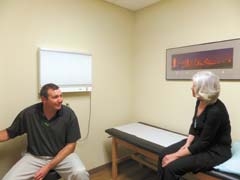Helping the Body Heal Itself
Dr. Steven Hardage of Eastern Oklahoma Orthopedic Center treats patients with platelet rich plasma.
By: Lorrie Ward | Category: Other | Issue: May 2014

Steve Hardage, M.D., is always happy to discuss PRP injections and other treatment options with patients.
When we hear the word “spinning,” many may think of an exercise class that gained popularity in recent years. But in Dr. Steve Hardage’s office at Eastern Oklahoma Orthopedic Center, “spinning” is an integral part of healing, as it helps create the PRP injections that are revolutionizing the treatment of chronic pain from injuries.
“PRP injections are a new, exciting thing in medicine to help tissues heal,” says Dr. Hardage, who is a primary care physician who specializes in sports medicine at EOOC Claremore with a group of orthopedic physicians. “What’s exciting is that it uses the good stuff from your own blood to make things want to heal.”
PRP stands for platelet rich plasma and it is used to help facilitate the healing of injured musculoskeletal tissue. To garner the needed platelets, a small sample of the patient’s own blood is drawn and put into a centrifuge that spins the blood at high speeds, extracting the platelets from the other components in the blood. Then this plasma, now packed with a high concentration of PRP will be injected all around the point of injury.
The reason this is so important is simply because the process uses the body’s own defense system. When the body is injured, the first thing it does is deliver an army of platelets to the injury site. These platelets not only have growth factors to facilitate healing, but they also attract stem cells, which are critical to the healing process. With PRP injections, a huge concentration of these platelets will be delivered directly to the needed area and will help “jump start” the body’s own injury defense.
Dr. Hardage explains that this “jump start” is often badly needed as the body has sometimes learned to ignore a chronic injury and will stop sending extra platelets to the site on its own. An injection of PRP jolts the process into action again. “The human body has enormous healing potential,” Dr. Hardage says. “By using PRP injections, we are getting the body’s attention and making it want to fix its problem.” He reports that while results are excellent with these treatments, patients should not expect this to be the “quick fix” that many are accustomed to with cortisone injections. “We are not just relieving the pain, we are helping the body to heal itself,” he says. “And that healing takes time.”
Dr. Hardage most frequently uses PRP injections on tendon injuries such as tennis elbow and Achilles tendonitis. He describes how one patient, who was a runner, had suffered long with plantar fasciitis, and although had received multiple cortisone injections, experienced no longstanding improvement. The patient received PRP treatments and within six weeks was back to running. Now, over two years later, he is relatively pain free.
In fact, athletes are the reason PRP injections became mainstream, as many professional athletes received the injections for injuries and brought PRP to the forefront of treatment options. At first it was one more thing to use in and around chronic tendon injuries, which Dr. Hardage points out are very hard to keep treated. He now uses this treatment on everyone from college football and baseball players to retired people with chronic pain.
Dr. Hardage is encouraged and enthusiastic about what the future holds for platelet rich plasma. “I believe PRP and stem cells are not only the future for tendon injuries,” he says. “They hold the future for healing in medicine as well.”
For more information, contact
Eastern Oklahoma Orthopedic Center
Eastern Oklahoma Orthopedic Center
For more information, contact:
918-341-0600
1110 W. Will Roger | Claremore 74017
View Map
www.eooc.com
Eastern Oklahoma Orthopedic Center Online:
More about Eastern Oklahoma Orthopedic Center:
More ArticlesCurrent Coupons/OffersSubscribe
For Free!
